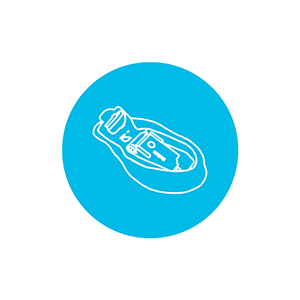Contact Information
Earlens Corporation4045A Campbell Avenue
Menlo Park, CA 94025
Website: Earlens.com
Email: customercare@earlens.com
To learn more about becoming an Earlens provider go to: Become a Provider - Earlens.
Get easy, 24/7 access to order forms, clinical research, marketing materials, and much more on Earlens.com.
If you are a provider, log in or request your username at webmaster@earlens.com
Earlens Corporation
The Earlens® Contact Hearing Solution directly activates the hearing system, delivering the broadest bandwidth available today and superior sound quality.
The idea for Earlens was born with Dr. Rodney Perkins, a pioneer in the hearing industry. During his experiments to vibrate the eardrum, patients praised the sound quality of what they heard. Across the next 25 years, the team worked to extend the concept into a commercial product. They created a non-surgical method to place a custom Lens stably on the eardrum, developed innovative custom manufacturing techniques, and completed a multi-center clinical trial that proved the device was safe and effective for treating hearing loss.
Acoustic device receivers face fundamental output limitations — particularly in the very low and very high frequencies in the real ear. Only Earlens provides audiometrically proven functional gain from 125 to 10,000 Hz even in a vented condition, with an average of 30-40 dB functional gain at 6,000 Hz and demonstrated audibility through 10,000 Hz. The Earlens Processor captures sound and converts it to an ultra low-power radio signal that carries high-fidelity audio data and powers the Lens. The Lens gently vibrates the eardrum to activate the natural hearing system. All this is achieved with a signal that is less than 1/400th of the power output of a mobile phone.
Read More
Continuing Education
Step by Step: The Audiologist’s Guide to Fitting the Inductive Earlens Contact Hearing Solution

Course: #37253Level: Introductory1 Hour
Troubleshooting a Silent Hearing Aid: Tools to Enhance Earlens Fittings

Course: #37251Level: Intermediate1 Hour
Silent Hearing Aid: Common Hearing Aid Concepts Through a New Lens

Course: #35944Level: Introductory0.5 Hours
The Earlens Difference. Why Contact Drive Succeeds Where Acoustic Devices Fail

Course: #35357Level: Introductory0.5 Hours
Videos
Earlens - An Inside Look at Earlens
January 12, 2021
Learn about the technology and team behind the revolutionary Earlens Contact Hearing Solution. Understand how the culture of innovation is constantly pushing the boundaries of what people had thought...
Watch VideoJeremy’s Earlens Experience
December 12, 2019
Learn how the Earlens Contact Hearing Solution has improved Jeremy's relationship with his wife.
Watch VideoNeil Sperling, MD: Why I Offer Earlens
December 12, 2019
Check out this testimonial by Dr. Neil Sperling on his experience with the new Earlens
Watch VideoScott Yerdon, AuD: My Favorite Earlens Patient Reaction
December 12, 2019
Check out this testimonial by renowned audiologist Dr. Scott Yerdon on his favorite Earlens patient reaction.
Watch VideoScott Yerdon, AuD: What Excites Me About Earlens
December 12, 2019
Check out this testimonial by renowned audiologist Dr. Scott Yerdon where he shares his experience with the revolutionary new Earlens
Watch VideoNews
Earlens Shares FDA Historical Ruling on OTC Hearing Aids
August 30, 2022
Ten Years of Research on the Earlens Bandwidth Advantage is Subject of New Article Series
April 13, 2022
Earlens Releases New Summary of the Body of Research on the Benefits of Extended-Bandwidth Hearing
December 22, 2021
Study Demonstrates Significant Listening Advantages with Earlens Hearing Technology
November 3, 2021
Earlens wins “Best Leadership Team” and “Best CEOs for Diversity” awards
July 14, 2021
Earlens Named to Time Magazine’s List of Best Inventions of 2020 for its Revolutionary Earlens® Contact Hearing Solution
January 21, 2021
Earlens Announces Partnership with Verily to Develop Next-Generation Capabilities for Earlens® Contact Hearing Solution
January 13, 2020
Ask the Expert
Earlens, Who is a Candidate and What are the Benefits?
July 25, 2022
Interviews
Earlens Releases Powerful Features to Enhance Fittings with New Earlens Fidelity™ 2021.1.1 Software
April 12, 2021
Busy Day? New Earlens Fidelity™ Fitting Software Provides a Smooth and Fast Fitting Experience
November 23, 2020
Resources
Full Bandwidth Streamed Audio with an Open-fit: Is It Possible?
Mandikal Vasuki et al. (2020) used collected double blind sound quality ratings for streamed music and speech content recorded through the Earlens system as well as four other premium acoustic hearing aid technologies. The results confirmed that normal hearing listener rated the sound quality for Earlens significantly higher than the other four technologies for both music and speech samples that were recorded for widely vented (or open dome) fittings. Long term average spectrum analysis of samples affirm that Earlens preserves spectral information that is lost through venting in traditional acoustic hearing aids resulting in higher ratings for sound quality. This provides confirmatory evidence that despite streaming codec being limited to 8kHz, listeners prefer fullness and clarity provided by broad frequency amplification achieved through a direct drive technology such as Earlens.
October 26, 2020Vaisberg et al (2020) gathered ratings of sound quality for multiple conditions of filtered stimuli presented through the wide bandwidth Earlens device. This is an extension of the method and results first shown by Moore & Tan in normal-hearing listeners in 2003, which demonstrated that improved sound quality results from having both extended low and high frequencies present – which were beyond the limits of conventional acoustic hearing aid technology; however in this paper those findings were confirmed in Earlens users with mild-sloping-to-severe sensorineural hearing loss in the as-clinically-fitted condition. This provides confirmatory evidence in the sound quality benefits of extended bandwidth of amplification through an Earlens system – and confirmed suprathreshold audibility that meets or exceeds the claimed range of 125-10,000 Hz for the target population in an independent and reputable research center. One of the most interesting results reported in this paper is that the “pedestal” of low frequency amplification down to 100 Hz is provided to all Earlens users even with a widely vented fitting. This low frequency amplification may be even more important than previously realized in terms of making the high frequencies more acceptable. This seems to be the case even for those with mild low frequency losses who would usually be fit with vented acoustic technology that is unlikely to provide low frequency amplification under these conditions. The result is that Earlens users are more likely to be able to benefit from the information encoded in the high frequencies, because balancing the highs with the lows makes the high frequencies more palatable and overall sound quality more natural.
October 26, 2020COVID-19 Webinar: Protecting Your Practice in an Uncertain Time
This webinar provides an overview of CARES Act programs and the Paycheck Protection Program (PPP) that can help ENT practices access capital and resources during this challenging time. Viewers also have the option to download a host of resources, like a PPP loan calculator and comparison of PPP vs. EIDL grants.
April 13, 2020This study summary compares the functional results attained within subjects with each system and demonstrates that the superior bandwidth performance of the Earlens Light-Driven System is maintained in the Inductive Earlens Contact Hearing Solution.
December 12, 2019Earlens Contact Hearing Solution
An overview of the Earlens Contact Hearing solution, including the system components and audibility advantage.
December 12, 2019Patient and Provider Experiences with the Inductive Earlens Contact Hearing Solution
This paper presents a snapshot of key data collected to date, focusing on the patient and provider experiences in terms of perceived benefit and satisfaction with the inductive system.
December 12, 2019The Magic of Direct Drive (Drew Dundas, PhD)
What is it that makes direct drive hearing solutions sound so good? This presentation identifies and defines various approaches to directly driving the middle ear system, and discusses advantages and disadvantages of middle ear implants and acoustic hearing aids.
December 12, 2019
















